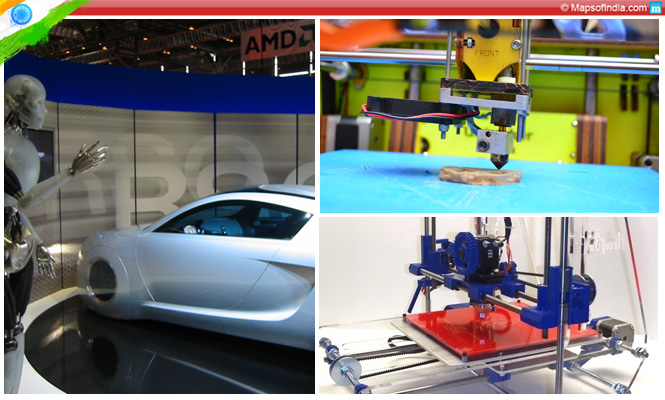
Before any product is approved for mass production – shoes, watches, cars the list is endless – a one-off prototype is created to understand and finalize all the visual cues and dimensions of the its design.
3D printing, also called additive manufacturing is the process involved in creating three dimensional solid objects from their digital models designed on various 3D modeling softwares. In a typical process of additive manufacturing, an object is created by laying down successive layers of material until the entire object is created. Each of these layers are the thinnest possible slices of the horizontal cross section of the object.
Before everything, a virtual design of the object to be created, is made in a computer aided design (CAD) file, with the help of a 3D modelling software, or its dimensions and surfaces are copied with the use of a 3D scanner. The scanner makes a digital copy of the object which can be accessed through the 3D modelling software.
How to create objects by 3D printers
In order to recreate the 3D model on the printer, the software slices the final model into a hundred thousand horizontal layers. Once the file is uploaded, the printer creates the object one layer at a time. The 3D printer reads every slice of the object as a 2D image and proceeds by blending each layer together, producing a 3D object.
Various 3D printers use different technologies to create objects. There are a number of ways of getting it done and are all mostly additive, varying in the method by which the layers are created to obtain the final object. Some printing processes use melting or softening of the material to produce the layers. Processes like the selective laser sintering (SLS) and fused deposition modelling (FDM) are the most common technologies that employ this method of printing. The most widely used, however is Stereolithography (SLA).
The method of selective laser sintering requires the use of a high power laser to fuse small particles of plastic, metal, ceramic or glass powders into the required 3D shape. The laser does selective fusing of the powdered material according to its scan of the cross sections generated by the 3D modelling software. Each cross section being scanned, the powder bed is lowered by one layer thickness. A fresh layer of material is applied on to it and the process is repeated until the object is completed. In this method, all the unused powder remains, and becomes a support structure for the object being created. All the unused powder is then used for the next printing.
The extrusion technique
The process of fused deposited modelling uses a plastic filament or metal wire unwound from a coil and provides material to an extrusion nozzle that controls the flow, and can turn it on and off. The nozzle is heated to melt the material and can travel in the vertical and horizontal planes by a numerically controlled mechanism by a computer- aided manufacturing (CAM) software. The object is then produced by extruding the melted material for the formation of layers as it hardens immediately once extruded from the nozzle.
The stereolithography method utilizes the process of photopolymerization to produce a solid part from a liquid. This method makes use of a liquid ultraviolet curable photopolymer resin and an ultraviolet laser to build the object’s layers one at a time. For each layer, the laser beam would trace a cross section of the part pattern on the liquid resin’s surface. The ultraviolet light then cures and solidifies the pattern traced on to the resin, and combines it with the layer below.
Once the pattern is traced the elevator platform in the machine setup descends by the thickness of a single layer and a resin filled blade sweeps across the particular cross section, re-coating it with fresh material. On the new liquid surface, the next layer pattern is traced, combining the previous layer. Hence a complete object is obtained. This process requires the use of supporting structures which also provide help attaching the part to the elevator platform.
3D printing is becoming popular
Over the last few years the popularity and demand of 3D printing has gone up and the technology now caters to a greater section of the public. Yet a lot of people are yet to try it out for themselves even though it has now been decades since 3D printing started. Manufacturers, however, have used it since long for their design processes in order to create prototypes for manufacturing and research. Using 3D printing for such purposes gives it the name of rapid prototyping.
The numerous applications of 3D printing include design visualization, prototyping, metal casting, architecture, education, geospatial, healthcare and entertainment.



